On this week's newsflash, we hear how the malaria parasite fools the foetal immune system, how orchids mimic bees to take advantage of hornets, and how a chemical from corals could treat neuropathic pain. Plus, we look back to this week in science history, and the first synthesis of Aspirin.
In this episode
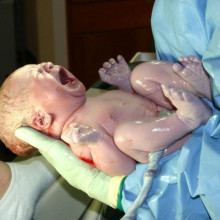
Bad news for malaria
Scientists have uncovered new insight into malaria, the deadly disease that affects around 500 million people every year. Sub Saharan African suffers the worst, with an annual death toll of 1 million people annually, mostly children aged between six months and three years.
 It was that statistic of the age-related risk that was the focus of this study in the journal PLoS Medicine, by Christopher King from Case Western Reserve University and his colleagues.
It was that statistic of the age-related risk that was the focus of this study in the journal PLoS Medicine, by Christopher King from Case Western Reserve University and his colleagues.
The research team followed up 586 babies born in Kenya from their birth up until their 3rd birthday. They took samples of umbilical cord blood form the babies and also some blood from the mothers.
As we might expect, some of the mothers were infected with malaria at the time of delivery. King and the team suspected that this would expose the baby to products made by the malaria parasites while still in the womb, and cause the babies' immune system to develop tolerance to malaria - a process by which the immune system learns what it should ignore when we are first born and what it should launch an attack on.
To test their ideas, they mixed malaria antigens with white blood cells from some of the babies with infected mothers and found that the cells reacted only very weakly to the malarial signal.
Babies whose mothers weren't infected, showed a very strong reaction and pumped out lots of inflammatory hormones.
This suggests that mothers that are infected with malaria pass trigger a tolerance to the malaria in their babies which means they ignore it rather than attack it.
Babies receive antibodies from their mother, which makes them protected from malaria for the first 6 months of life. After that, the baby because vulnerable. But if their immune system thinks that malaria is friend rather than foe, then the vaccines will have to tackle this re-programming error if they are going to work.
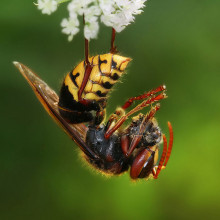
04:01 - Malaria, Orchids, Hornets and Coral
Malaria, Orchids, Hornets and Coral
On this week's newsflash, we hear how the malaria parasite fools the foetal immune system, how orchids mimic bees to take advantage of hornets, and how a chemical from corals could treat neuropathic pain. Plus, we look back to this week in science history, and the first synthesis of Aspirin.
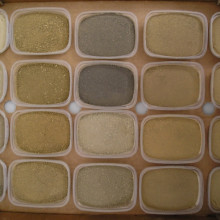
Urgent need for soil maps
Good quality, healthy soil is the stuff that underpins healthy human populations by ensuring we all have enough to eat. They also play a vital role in regulating the climate. But get it wrong, and it can spell disaster.
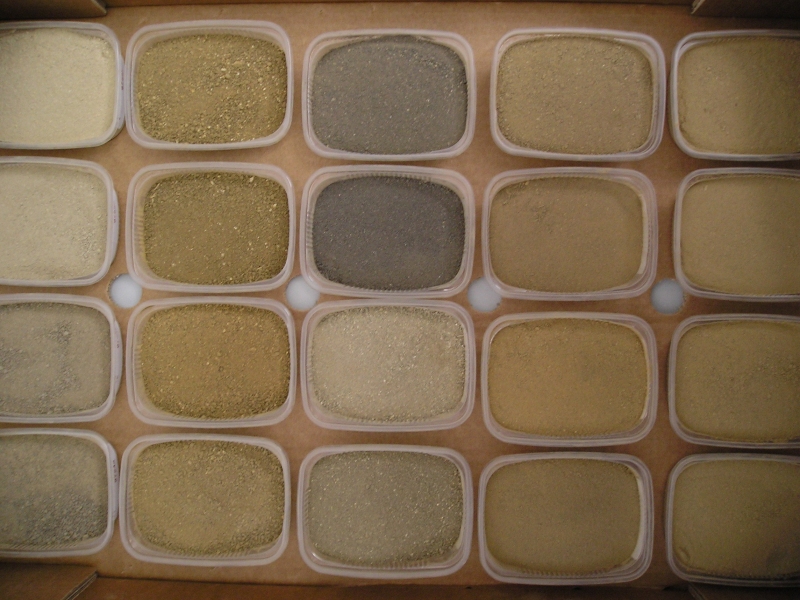 Now a group of scientists publishing in the journal Science have highlighted the urgent need to create a new map of the world's soil. Using the very latest digital, mobile and online technology to assess the state of the dirt beneath our feet may initially seem a bit excessive, but it could provide a crucial way of managing soils in particular areas, preventing their degradation and ultimately ensuring food security.
Now a group of scientists publishing in the journal Science have highlighted the urgent need to create a new map of the world's soil. Using the very latest digital, mobile and online technology to assess the state of the dirt beneath our feet may initially seem a bit excessive, but it could provide a crucial way of managing soils in particular areas, preventing their degradation and ultimately ensuring food security.
Soil maps essentially show the types and properties of soils in different areas - how much water they hold, what they are made from - all sorts of information that is vital for effective land management. Irrigation, using the limited global supplies of freshwater, is a key area where local soil type conditions needs to be taken into account. For example, in central North China Plain, more water is often pumped into fields than it can fact hold, wasting vast quantities of precious water.
The first world soil map made by the UN FAO in 1981 and it's been put to all sorts of important uses including studies of climate change, food production and land degradation. The problem is it has a very low resolution, and it doesn't include all the types of information and soil properties that we are now interested in, in the 21st century.
The 'Policy forum' paper is calling for the international collaboration to compile of a detailed, 3D soil map that would be freely available over the internet to be used by scientists, land-use planners and policy makers.
Foundations have already been laid by the Global Soil Map.net project. Started in 2006 in response to policy makers who were increasingly complaining that they couldn't get hold of useful information to answer questions like how much Carbon is locked up and emitted by soils in a particular region?
At the moment, only around 1/3 of the world's ice-free land have soil maps available at 1:1 million scale or finer. So there is a lot of information that still needs to be collected, as well as that existing information to be brought together and made readily accessible to different users, everyone from farmers to policy makers and scientists.
To make a digital soil map, in essence involves surveying particular sites for the properties of the soil and then extrapolating that to a wider area that hasn't been directly sampled - because you can't sample everywhere. Information about the physical and biological components of the soil can then be combined with geographical information on farming systems, poverty levels, crop yields, road density and all sorts of other human factors.
The hope is that once all this information has been gathered and assimilated into a single resource, it can be used to make recommendations on how soils in particular areas should best be used, and changes over time can be monitored. Ultimately, the aim is to reverse soil degradation and improve food security and people's livelihoods.
Ocean therapy
Scientists have discovered a possible new painkiller inside a type of soft coral living on Green Island, a small volcanic peak just off the coast of Taiwan.
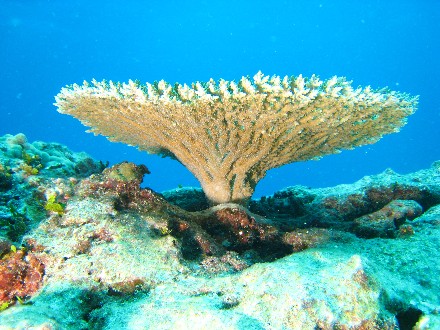 Dr Zhi-Hong and colleagues from the National Sun Yat-Sen Univeristy in China have a paper in the British Journal of Pharmacology in which they test a compound called capnellene inside the Kenya Tree Coral (Capnella imbricata) - which look like little white trees. This molecule could prove a vital step forward for combating neuropathic pain.
Dr Zhi-Hong and colleagues from the National Sun Yat-Sen Univeristy in China have a paper in the British Journal of Pharmacology in which they test a compound called capnellene inside the Kenya Tree Coral (Capnella imbricata) - which look like little white trees. This molecule could prove a vital step forward for combating neuropathic pain.
People with Neuropathic pain suffer from intense pain from a stimulus that should normally only cause mild discomfort, like a cold draft. Some people even feel pain with no stimulus at all and it's a condition that may affect as much as 1 in 100 people in the UK alone. It can be triggered by nerve damage associated with diabetes and standard pain killers like aspirin are little help.
Inflammation of the nervous system plays an important role in causing neuropathic pain, by activating the cells that surround nerve cells, called microglia and astrocytes, and when they are active they magnify pain signals travelling along the nerves making the pain sensation more intense.
Capnellene was originally discovered in 1974 but only recently scientists began to realise how useful it might be. The molecule has a very different structure to other painkillers.
The research team tested out capnellene both on isolated nerve cells and also on laboratory rats, and found that it reduced pain-related activities in nerve cells and the rats that suffer from neuropathic pain showed fewer pain responses when they were given doses of the compound.
It may seem strange that a coral would have developed a pain killing chemical, but life on a coral reef is tough and competitive, with so many species living in close proximity, and many of them have evolved complex chemical defences to help give them the upper hand. It just happens that some of those active chemicals have affects on other types of animal.
It's early days, but this discovery does offer longterm hope for sufferers of neuropathic pain and points the way towards a new generation of pain killers, that are inspired by the sea.
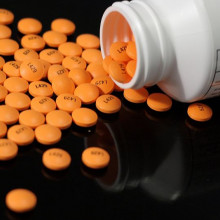
13:07 - This week in science history - The discovery of Aspirin
This week in science history - The discovery of Aspirin
Sarah Castor-Perry
This week in science history saw, in 1897, Felix Hoffman first synthesise a stable form of acetylsalicylic acid for medical use, better known as aspirin.
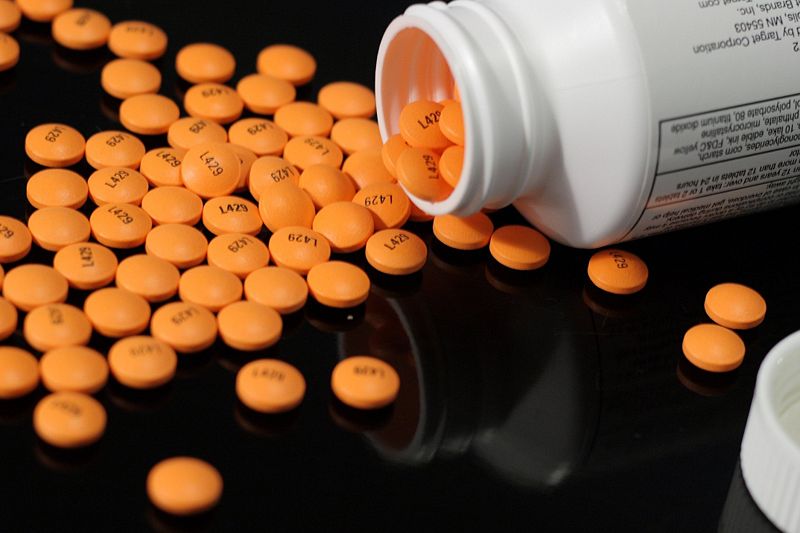 Aspirin, or acetylsalicylic acid, is a 'salicylate' drug that as well as its best known effect as an 'analgesic' to reduce aches and pains can also be used as an 'antipyretic' to control fever, and as an anti-inflammatory to reduce inflammation. It also has the effect of making the blood less likely to clot, known as anti-coagulation. It was the first 'non steroidal anti inflammatory drug' to be discovered (another example being ibuprofen), and it had the huge benefits of reducing pain without impairing consciousness and was not addictive unlike opiate painkillers such as laudanum.
Aspirin, or acetylsalicylic acid, is a 'salicylate' drug that as well as its best known effect as an 'analgesic' to reduce aches and pains can also be used as an 'antipyretic' to control fever, and as an anti-inflammatory to reduce inflammation. It also has the effect of making the blood less likely to clot, known as anti-coagulation. It was the first 'non steroidal anti inflammatory drug' to be discovered (another example being ibuprofen), and it had the huge benefits of reducing pain without impairing consciousness and was not addictive unlike opiate painkillers such as laudanum.
Salicylate based medicines derived from plants like meadowsweet and willow trees had already been in use for over 3 and a half thousand years by the 19th century, to reduce aches and pains and fever. In fact the name 'salicylic acid' comes from the Latin name for the willow tree, Salix. In the 1820s and 30s, chemists in Italy and Germany managed to purify the active chemical found in these plants - salicylic acid. The medicinal use of this grew in the mid 1800s, but it did have several drawbacks, including the fact that it caused stomach pain, ulcers and even stomach bleeding.
Around this time, an industry began to grow in Germany to investigate medicines that could be derived from cloth dyes made from coal tar. Surprising as it might sound given the starting point of coal tar, a lot of compounds were found that could be used to reduce fever and pain. A German dye firm called Friedrich Bayer and Company began to expand to investigate medicines further, seeing that there was money to be made. It was this company that Hoffman joined as a young man in 1894, to work with two chemists called Eichengrün and Dreser.
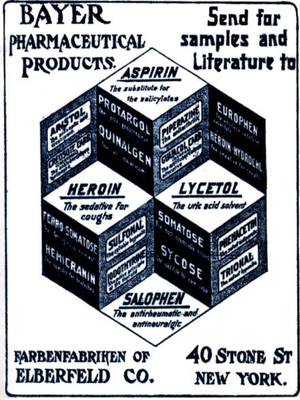 In 1897, Eichengrün instructed Hoffman to find an alternative form of salicylic acid that would be less irritating to the stomach, but would still produce anti fever and pain effects. In his lab book entry for the 10th of October 1897, Hoffman declared that he had synthesised a pure form of acetylsalicylic acid by refluxing salicylic acid with acetyl anhydride. This ended up producing a much purer and more stable form of acetylsalicylic acid than had been produced before using other techniques. Clinical trials suggested that it was just as effective as salicylic acid without many of the unpleasant side effects. However, it was not until 1899 that the name Aspirin was decided on and the Bayer began producing it for use as a prescription drug. It was not available over the counter until after the turn of the century.
In 1897, Eichengrün instructed Hoffman to find an alternative form of salicylic acid that would be less irritating to the stomach, but would still produce anti fever and pain effects. In his lab book entry for the 10th of October 1897, Hoffman declared that he had synthesised a pure form of acetylsalicylic acid by refluxing salicylic acid with acetyl anhydride. This ended up producing a much purer and more stable form of acetylsalicylic acid than had been produced before using other techniques. Clinical trials suggested that it was just as effective as salicylic acid without many of the unpleasant side effects. However, it was not until 1899 that the name Aspirin was decided on and the Bayer began producing it for use as a prescription drug. It was not available over the counter until after the turn of the century.
The popularity of Aspirin grew and grew in the first few decades of the 20th century, especially after its widespread and successful use in controlling pain and fever in victims of the 1918 flu pandemic. However, its use by the public around the world was reduced on the introduction of paracetamol in 1956 and ibuprofen in 1969. Alarming evidence that it might cause Reye's syndrome - a potentially fatal disease involving organ failure - in children after being used to treat them for chicken pox also decreased its popularity. It is now advised not to be given to children under 16. Its anticoagulate effects were shown in the 1970s, and after this aspirin came back into widespread use and is still in use today as a preventative measure against strokes and heart attacks by reducing the likelihood of a blood clot.
With a discovery of such magnitude and with money and fame to be had, there is unsurprisingly a lot of controversy surrounding the discovery of aspirin. Eichengrün released a paper in 1949, three years after Hoffman's death, arguing that he should be credited with the discovery of aspirin and that Hoffman had just been following his instructions. This account of events was not supported until 1999, when a researcher at Strathclyde University examined the case and came out in support of Eichengrün. Bayer, the pharmaceutical company that Hoffman and Eichengrün had been working for at the time dismissed the findings and stood behind Hoffman. As of 2004, the controversy is still unresolved.
The events that led to the production and widespread use of aspirin are an important chapter in the history of medicine. It was the first modern painkilling drug that could be used without affecting a person's day to day activities and has brought relief to millions of people over the years. Although less in use as a painkiller now, it still plays a vital role in medicine.
Related Content
- Previous WCSJ 2009 - New Media Strand
- Next Kat's Best Bits









Comments
Add a comment